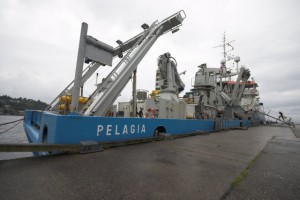Roberts, J.M., Davies, A.J., Henry, L.-A., Dodds, L.A., Duineveld, G.C.A., Lavaleye, M.S.S., Maier, C., van Soest, R.W.M., Bergman, M.J.N., Hühnerbach, V., Huvenne, V.A.I., Sinclair, D.J., Watmough, T., Long, D., Green, S.L. & van Haren, H.
Published in Marine Ecology Process Series 397.
 The Mingulay reef complex in the Sea of the Hebrides west of Scotland was first mapped in 2003 with a further survey in 2006 revealing previously unknown live coral reef areas at 120 to 190 m depth. Habitat mapping confirmed that distinctive mounded bathymetry was formed by reefs of Lophelia pertusa with surficial coral debris dating to almost 4000 yr. Benthic lander and mooring deployments revealed 2 dominant food supply mechanisms to the reefs: a regular rapid downwelling of surface water delivering pulses of warm fluorescent water, and periodic advection of high turbidity bottom waters. Closed chamber respirometry studies suggest that L. pertusa responds to seawater warming, such as that seen during the rapid downwelling events, with increases in metabolic rate. Lipid biomarker analysis implies that corals at Mingulay feed predominantly on herbivorous calanoid copepods. Integrating geophysical and hydrographical survey data allowed us to quantify the roles of these environmental factors in controlling biodiversity of attached epifaunal species across the reefs. Longitudinal structuring of these communities is striking: species richness (α) and turnover (β) change significantly west to east, with variation in community composition largely explained by bathymetric variables that are spatially structured on the reef complex. Vibro-cores through the reef mounds show abundant coral debris with significant hiatuses. High resolution side-scan sonar revealed trawl marks in areas south of the coral reefs where vessel monitoring system data showed the highest density of local fishing activity. The interdisciplinary approach in this study allowed us to record the food supply and hydrographic environment experienced by L. pertusa and determine how it may be ecophysiologically adapted to these conditions. Improved basic understanding of cold-water coral biology and biodiversity alongside efforts to map and date these long-lived habitats are vital to development of future conservation policies.
The Mingulay reef complex in the Sea of the Hebrides west of Scotland was first mapped in 2003 with a further survey in 2006 revealing previously unknown live coral reef areas at 120 to 190 m depth. Habitat mapping confirmed that distinctive mounded bathymetry was formed by reefs of Lophelia pertusa with surficial coral debris dating to almost 4000 yr. Benthic lander and mooring deployments revealed 2 dominant food supply mechanisms to the reefs: a regular rapid downwelling of surface water delivering pulses of warm fluorescent water, and periodic advection of high turbidity bottom waters. Closed chamber respirometry studies suggest that L. pertusa responds to seawater warming, such as that seen during the rapid downwelling events, with increases in metabolic rate. Lipid biomarker analysis implies that corals at Mingulay feed predominantly on herbivorous calanoid copepods. Integrating geophysical and hydrographical survey data allowed us to quantify the roles of these environmental factors in controlling biodiversity of attached epifaunal species across the reefs. Longitudinal structuring of these communities is striking: species richness (α) and turnover (β) change significantly west to east, with variation in community composition largely explained by bathymetric variables that are spatially structured on the reef complex. Vibro-cores through the reef mounds show abundant coral debris with significant hiatuses. High resolution side-scan sonar revealed trawl marks in areas south of the coral reefs where vessel monitoring system data showed the highest density of local fishing activity. The interdisciplinary approach in this study allowed us to record the food supply and hydrographic environment experienced by L. pertusa and determine how it may be ecophysiologically adapted to these conditions. Improved basic understanding of cold-water coral biology and biodiversity alongside efforts to map and date these long-lived habitats are vital to development of future conservation policies.
Request PDF
| To request a PDF copy of this paper, please enter your email address below: Your email address is not stored, it is only used to send an email with an attached PDF to you. |
Full citation
Roberts, J.M., Davies, A.J., Henry, L.-A., Dodds, L.A., Duineveld, G.C.A., Lavaleye, M.S.S., Maier, C., van Soest, R.W.M., Bergman, M.J.N., Hühnerbach, V., Huvenne, V.A.I., Sinclair, D.J., Watmough, T., Long, D., Green, S.L. & van Haren, H. (2009) “Mingulay reef complex, northeast Atlantic: an interdisciplinary study of cold-water coral habitat, hydrography and biodiversity.” Marine Ecology Progress Series 397: 139-151.
